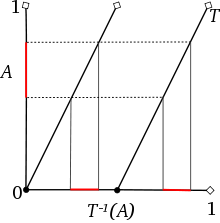Measure-preserving dynamical system
In mathematics, a measure-preserving dynamical system is an object of study in the abstract formulation of dynamical systems, and ergodic theory in particular.
Definition
A measure-preserving dynamical system is defined as a probability space and a measure-preserving transformation on it. In more detail, it is a system
with the following structure:
- is a set,
- is a σ-algebra over ,
- is a probability measure, so that μ(X) = 1, and μ(∅) = 0,
- is a measurable transformation which preserves the measure , i.e., .
This definition can be generalized to the case in which T is not a single transformation that is iterated to give the dynamics of the system, but instead is a monoid (or even a group, in which case we have the action of a group upon the given probability space) of transformations Ts : X → X parametrized by s ∈ Z (or R, or N ∪ {0}, or [0, +∞)), where each transformation Ts satisfies the same requirements as T above.[1] In particular, the transformations obey the rules:
- , the identity function on X;
- , whenever all the terms are well-defined;
- , whenever all the terms are well-defined.
The earlier, simpler case fits into this framework by defining Ts = Ts for s ∈ N.
Examples

Examples include:
- μ could be the normalized angle measure dθ/2π on the unit circle, and T a rotation. See equidistribution theorem;
- the Bernoulli scheme;
- the interval exchange transformation;
- with the definition of an appropriate measure, a subshift of finite type;
- the base flow of a random dynamical system;
- the flow of a Hamiltonian vector field on the tangent bundle of a closed connected smooth manifold is measure-preserving (using the measure induced on the Borel sets by the symplectic volume form) by Liouville's theorem (Hamiltonian);[1]
- for certain maps and Markov processes, the Krylov–Bogolyubov theorem establishes the existence of a suitable measure to form a measure-preserving dynamical system.
Homomorphisms
The concept of a homomorphism and an isomorphism may be defined.
Consider two dynamical systems and . Then a mapping
is a homomorphism of dynamical systems if it satisfies the following three properties:
- The map is measurable.
- For each , one has .
- For μ-almost all , one has .
The system is then called a factor of .
The map is an isomorphism of dynamical systems if, in addition, there exists another mapping
that is also a homomorphism, which satisfies
- for μ-almost all , one has ;
- for ν-almost all , one has .
Hence, one may form a category of dynamical systems and their homomorphisms.
Generic points
A point x ∈ X is called a generic point if the orbit of the point is distributed uniformly according to the measure.
Symbolic names and generators
Consider a dynamical system , and let Q = {Q1, ..., Qk} be a partition of X into k measurable pair-wise disjoint pieces. Given a point x ∈ X, clearly x belongs to only one of the Qi. Similarly, the iterated point Tnx can belong to only one of the parts as well. The symbolic name of x, with regards to the partition Q, is the sequence of integers {an} such that
The set of symbolic names with respect to a partition is called the symbolic dynamics of the dynamical system. A partition Q is called a generator or generating partition if μ-almost every point x has a unique symbolic name.
Operations on partitions
Given a partition Q = {Q1, ..., Qk} and a dynamical system , we define T-pullback of Q as
Further, given two partitions Q = {Q1, ..., Qk} and R = {R1, ..., Rm}, we define their refinement as
With these two constructs we may define refinement of an iterated pullback
which plays crucial role in the construction of the measure-theoretic entropy of a dynamical system.
Measure-theoretic entropy
The entropy of a partition Q is defined as[2][3]
The measure-theoretic entropy of a dynamical system with respect to a partition Q = {Q1, ..., Qk} is then defined as
Finally, the Kolmogorov–Sinai metric or measure-theoretic entropy of a dynamical system is defined as
where the supremum is taken over all finite measurable partitions. A theorem of Yakov Sinai in 1959 shows that the supremum is actually obtained on partitions that are generators. Thus, for example, the entropy of the Bernoulli process is log 2, since almost every real number has a unique binary expansion. That is, one may partition the unit interval into the intervals [0, 1/2) and [1/2, 1]. Every real number x is either less than 1/2 or not; and likewise so is the fractional part of 2nx.
If the space X is compact and endowed with a topology, or is a metric space, then the topological entropy may also be defined.
See also
- Krylov–Bogolyubov theorem on the existence of invariant measures
- Poincaré recurrence theorem
References
- Walters, Peter (2000). An Introduction to Ergodic Theory. Springer.
- Ya. G. Sinai, (1959) "On the Notion of Entropy of a Dynamical System", Doklady of Russian Academy of Sciences 124, pp. 768–771.
- Ya. G. Sinai, (2007) "Metric Entropy of Dynamical System"
Further reading
- T. Schürmann and I. Hoffmann, The entropy of strange billiards inside n-simplexes. J. Phys. A 28(17), page 5033, 1995. PDF-Document (gives a more involved example of measure-preserving dynamical system.)
- Michael S. Keane, "Ergodic theory and subshifts of finite type", (1991), appearing as Chapter 2 in Ergodic Theory, Symbolic Dynamics and Hyperbolic Spaces, Tim Bedford, Michael Keane and Caroline Series, Eds. Oxford University Press, Oxford (1991). ISBN 0-19-853390-X (Provides expository introduction, with exercises, and extensive references.)
- Lai-Sang Young, "Entropy in Dynamical Systems" (pdf; ps), appearing as Chapter 16 in Entropy, Andreas Greven, Gerhard Keller, and Gerald Warnecke, eds. Princeton University Press, Princeton, NJ (2003). ISBN 0-691-11338-6